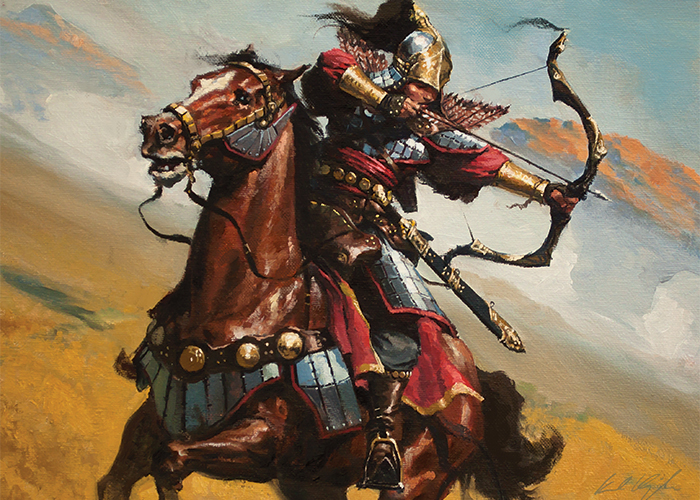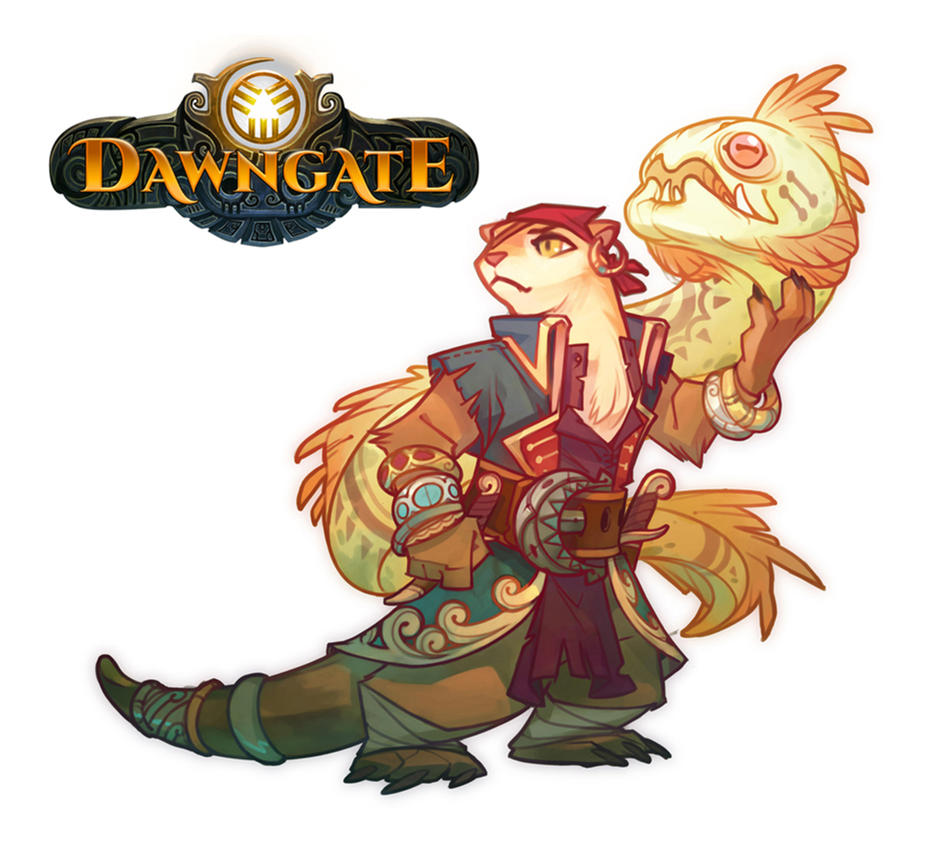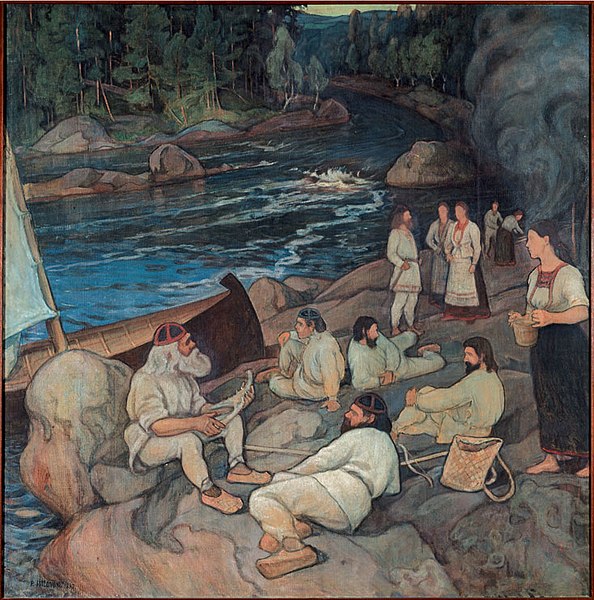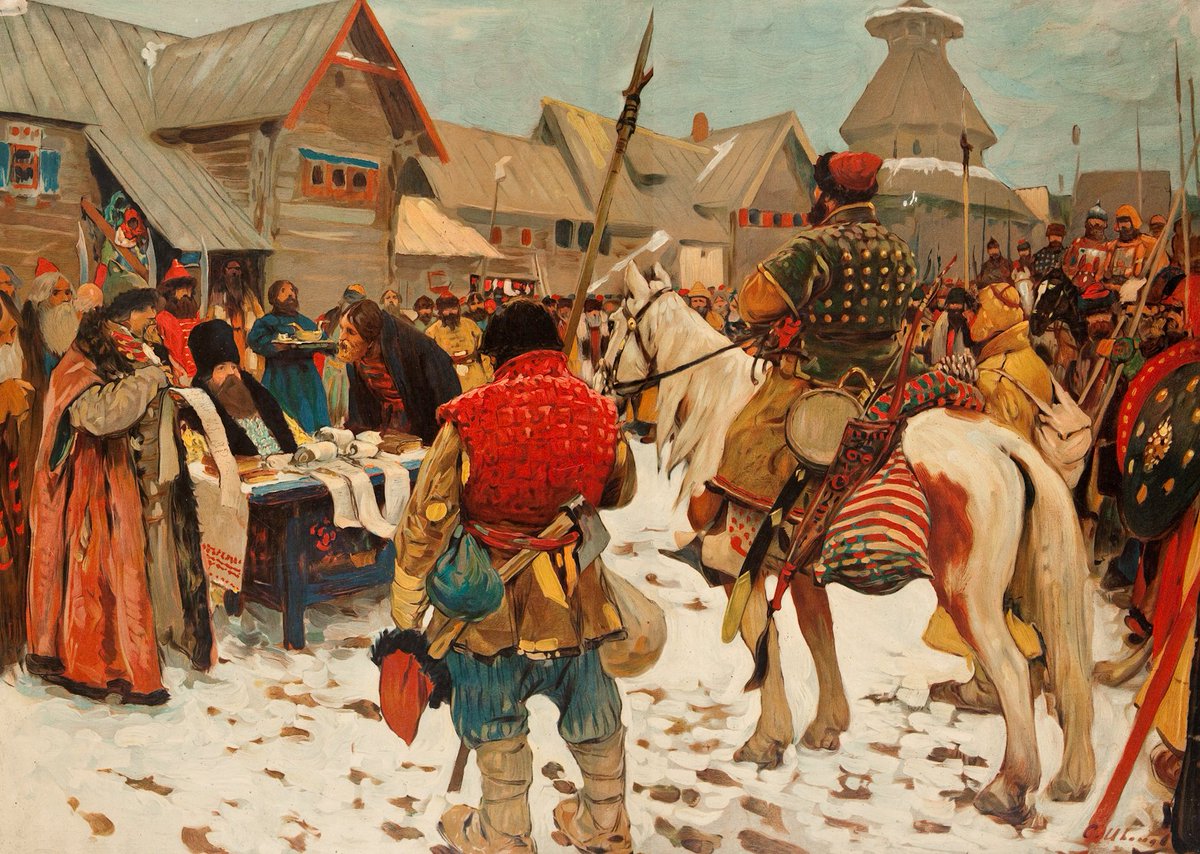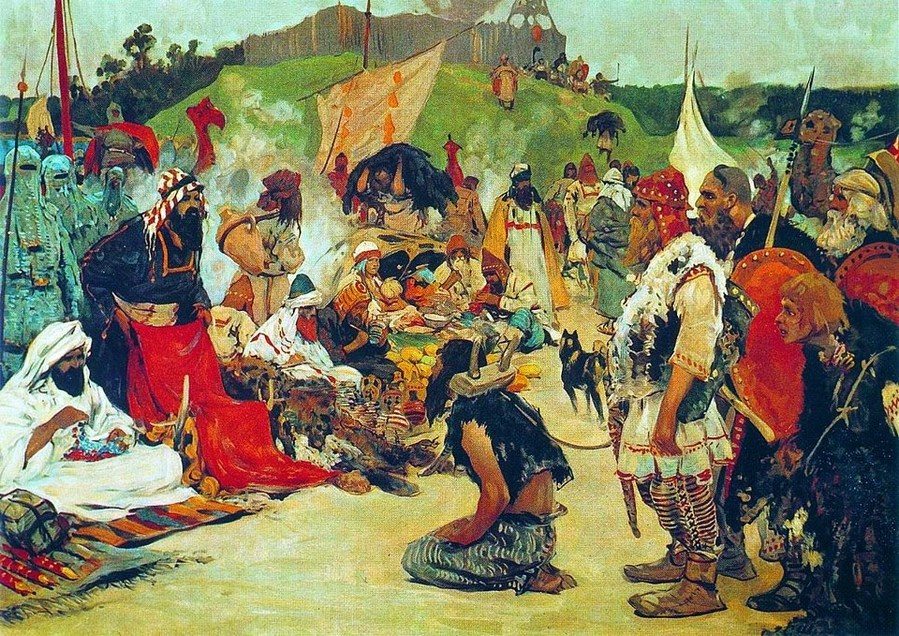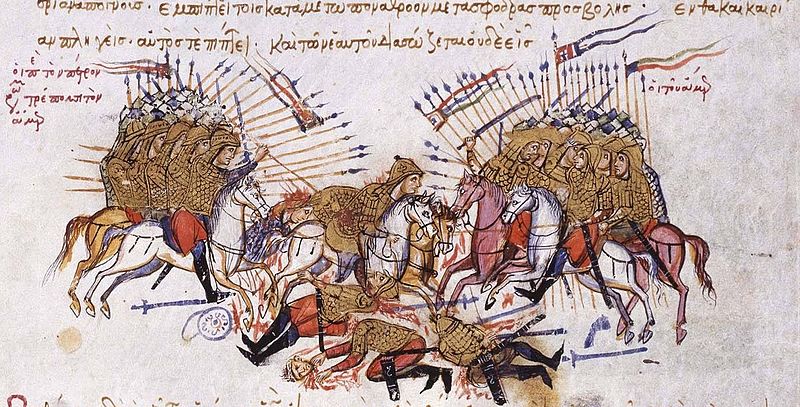Here are last of the peoples of the Meager Country. The previous posts in this series are about the Rowing People, and the other Peoples of the River. So now the Meager Country has 5 new types of people and 11 different ethnic groups, which I think is a good number. As before, each group has its own spirit boon which players can gain access to by being initiated into that group.
They look just like the Bronze Folk. Maybe they’re a little
shorter, maybe their eyes are a little brighter, but the broad strokes are the
same. Even their style of dress is familiar, but far more practical. Their faces are covered in ritual scars, their legs are bent from a
lifetime in the saddle, their color is green, and their Seven-Stranded Banner
has flown over the steppe for longer than any other. They would laugh at the
fat merchants of the Bronze city, who think they know horses, who think they
know archery. Every Seluk was born in a tent, underneath the endless sky, and
each will ride a horse before they learn to walk. Their bows are recurve and
their mighty tents are pulled on wheels by teams of bulls. They heard goats,
sheep, cattle, and keep wolfish dogs who run beside the herds to keep them from
straying. Their favorite drink is a hot thick liquid with the colour and taste of mud, they call it tea. Their horses are swift but tire quickly, every man and woman except the poorest owns several. The Seluk confederacy is a spiritual unity. Eight
times the world has ended when the steppe was set alight and the rivers ran with blood and nine
times it has risen from the ash. Each time, the confederacy has been united
again. The souls of the Seluk people will always find each other on the fresh
steppe and ride into the Final War as one. There are seven Seluk clans but each
is divided into three strata. The Bull strata take after The Horned One, they
are herders and craftspeople. The Horse strata takes after Thunder Shaker, they
are warriors and defenders. Finally, the Eagle strata who take after Sky Father
himself, they are shamans, generals, and leaders. These functions are divinely
appointed, if one does not perform their function they endanger the survival of
the Seluks past the next Final War. The Seluk Confederacy controls the eastern
bank of the river Sargal up until it forks. Their domain is threatened by the
Kazan, who push west every day. The Seluks merely tolerate the other peoples
who inhabit their steppe. These others are but ephemeral, their civilizations
particular and not eternal like the wheel and recurve bow and Seven-Stranded
Banner. The whole Confederacy is organized from the Eagle Tent, a massive
mountain of yellow fabric and hide which moves with the turning seasons up and
down the river. Their current Khagan is Bahram of the Moon-Kissed clan, who are represented by a strand of white hair in the great banner. He is convinced the Final War will happen in his lifetime and is trying to introduce writing to the Seluks. He wishes to create a network of messenger birds so he always knows where his soldiers are.
Guardian Spirits: Thunder Shaker, Sky Father, The Horned One,
The Twins, The Sun and Moon
Languages: Seluk Speech (Close enough to Bronze Talk to be understood by speakers of that language)
-Bull Strata Boon: At day break, can drink milk from a hollowed out cow horn which has not been properly treated as to be used as a drinking horn (smells terrible, everything in it tastes like wet cow) to do all physical work twice as quickly until the sun is risen to it's highest point in the sky
-Horse Strata Boon: Can dip an arrow tip in the blood of an enemy and wrap it in strands of horse hair for a day to make the arrow do an extra 2d8 lightning damage to the target who's blood was used to make the arrow
-Eagle Strata Boon: Can whisper a person's name to a feather from a bird of prey and throw it to the wind. Whichever way the feather blows is the direction of the person named. Can eat the egg lay laid by a bird of prey to see through its eyes but not its ears for a day. This causes temporary blindness and usually nausea.
Speed 30ft
-Adrenaline, gain 2 temporary hitpoints, to a maximum of 2 +
your level, at the beginning of your turn in combat.
-Gain advantage on all perception checks which rely on smell
-Can communicate in a basic way with birds of prey and wolves. You can ask yes/no questions or questions which can be easily answered with a bob of a head or the stretching of a wing, such as asking for directions. It's a horrible idea to always trust these animals though. They want you to get lost so they can eat you when you tire.
-Gain advantage on all perception checks which rely on smell
-Can communicate in a basic way with birds of prey and wolves. You can ask yes/no questions or questions which can be easily answered with a bob of a head or the stretching of a wing, such as asking for directions. It's a horrible idea to always trust these animals though. They want you to get lost so they can eat you when you tire.
The Koto Kete of the United Femur: Their last confederacy
was broken when Khan Naran broke the femur of a sacred ewe during the
moot-feast, leading to years of bloody war. Now they are joined together once
again. Their domain rests in the lower river region and travels up the west
bank until the river forks. Their warriors file their teeth to points and obsess over virtue and spiritual purity, which are both deeply intertwined. They have a tight grip on trade coming westward and
extract tribute as they please. Sometimes this tribute is knowledge, great
teachers are invited to spend years with the Koto Kete before continuing their
scholarly journeys. Cults from Voich are making becoming more and more popular
with the Koto Kete and the word of disgraced Besharan theologians is becoming
accepted among them. The emissarys of the Sultan have been warmly welcomed by the Koto Kete and they work closely with them to protect trade going up and down the river. The Koto Kete are led by Khan Sarnai and her council of elders from each of the
10 Koto-Kete tribes. The moot-feast is held in the coldest month of winter. Leaders from all the tribes gather under one tent to plan
the confederacy’s future. Every ten seasons, the elders elect a new Khan. The
warriors compete in tests of endurance in the frigid weather, sometimes they
die of hypothermia. It is a great honor to be chosen by the Winter Wind this
way. Sarnai’s greatest ambition is to reform the Koto Kete so that officers are
chosen based on merit rather than lineage, she will probably die mysteriously
in a hunting accident.
Guardian Spirits: Black Wolf, Yellow Hawk, Sky Father, The
Four Winds of the World
Languages: Narrow Tongue, Trade Tongue
-Can sing to a silver mirror for 6 hours and hold it in the smoke of a ritual sacrifice to make the mirror show the true face of the world on it's surface. In the mirror, spirits appear as they are in the spirit world, magical disguises are erased, and crimes appear on people disfiguring the flesh while the good deeds look like beauty marks. The mirror loses this ability after 3 days.
-Can sing to a silver mirror for 6 hours and hold it in the smoke of a ritual sacrifice to make the mirror show the true face of the world on it's surface. In the mirror, spirits appear as they are in the spirit world, magical disguises are erased, and crimes appear on people disfiguring the flesh while the good deeds look like beauty marks. The mirror loses this ability after 3 days.
 |
| 7th Century Reliquary, Don river area |
The Kazan:
At the end of the Boulevard of Khans, in the Jet Palace, on a pile of twisted iron crowns, on a huge velvet pillow, sits a massive serpentine skull covered with gold leaf and festooned with jewels and precious stones. This is Sargal Toihor. Her spirit flies across the Meager Country like a bad wind. Milk curdles, women miscarry, yak sicken and die in her wake. She chose the Kazan two centuries ago, when they were just a minor tribe of the Koto Kete. They found her skull, hidden far north at the beginning of the endless forest of the Untamo and brought it to a place south of the river Altai. Here they have built the Venomous City and expand their new domain. They have two High Khans. One’s role is spiritual, he spends his days lavishing Toihor’s skull with praise and devotion. The other is a military leader, she keeps track of the movements of all the Kazan warbands. Lesser Khans and officers are picked from several powerful families. The lesser Khans operate with independence but compete for the favor of Sargal-Toihor and the High Khans. Toihor rewards princes and warriors who act with cunning and disrespect for human life with black scales and venomous breath and incredible strength. They can decapitate a man with a single arrow. These chosen warriors are waited upon by spindly kobolds who show up in the Venomous City at random. They were once vermin, but now they are little beady eyes and twisted ears for the Great Jet Serpent. Toihor values trade highly. She needs more jewels for her throne and greater power over all the business going up and down the Meager Country’s rivers. How she would love to speak with someone from the Bronze City. If only such a place existed when she had flesh instead of bone. Make no mistake, it will not be long before this whole country belongs to the Kazan.
At the end of the Boulevard of Khans, in the Jet Palace, on a pile of twisted iron crowns, on a huge velvet pillow, sits a massive serpentine skull covered with gold leaf and festooned with jewels and precious stones. This is Sargal Toihor. Her spirit flies across the Meager Country like a bad wind. Milk curdles, women miscarry, yak sicken and die in her wake. She chose the Kazan two centuries ago, when they were just a minor tribe of the Koto Kete. They found her skull, hidden far north at the beginning of the endless forest of the Untamo and brought it to a place south of the river Altai. Here they have built the Venomous City and expand their new domain. They have two High Khans. One’s role is spiritual, he spends his days lavishing Toihor’s skull with praise and devotion. The other is a military leader, she keeps track of the movements of all the Kazan warbands. Lesser Khans and officers are picked from several powerful families. The lesser Khans operate with independence but compete for the favor of Sargal-Toihor and the High Khans. Toihor rewards princes and warriors who act with cunning and disrespect for human life with black scales and venomous breath and incredible strength. They can decapitate a man with a single arrow. These chosen warriors are waited upon by spindly kobolds who show up in the Venomous City at random. They were once vermin, but now they are little beady eyes and twisted ears for the Great Jet Serpent. Toihor values trade highly. She needs more jewels for her throne and greater power over all the business going up and down the Meager Country’s rivers. How she would love to speak with someone from the Bronze City. If only such a place existed when she had flesh instead of bone. Make no mistake, it will not be long before this whole country belongs to the Kazan.
Guardian Spirits: Sargal-Toihor the Jet Serpent who wears
600 crowns and commands a million archers
-Gain resistance to acid damage and advantage on constitution saving throws against poisons while wearing a belt of snakeskin with a piece of jet set in it. The piece of jet absorbs any poisons which effect you. If you are favored by Sargal-Toihor, it can turn into a serpent with jet fangs whose bite inflicts all the poisons absorbed by the jet stone on its victim. It may just as easily bite you if Toihor wishes it too.
 |
| Kalka by Pavel Ryzhenko |
The kingdom of Voich is doomed. In a century or two the Kazan will burn it to the ground. But now, it shudders on in a hilled part of the steppe far west of the Sargal. The kingdom’s most notable export is the courage flower, which the Koto Kete buy is vast quantities. Its bright red petals are a powerful stimulant but the plant will only bloom where blood has been shed. Incidentally, Voich is one of the few Pomroy kingdoms to do away with public executions. They execute criminals on courage flower fields instead. Voich also produces wonderful tapestries which make their way to the Bronze City from time to time, they will inspire a generation of artists in an age far away from this one. There are four aristocratic families (Alma, Alba, Alra, and Alta) who control Voich, their grip is iron and they live in a world wholly different from that of the peasantry, who are no better than slaves. In the court of Voich, there are a hundred titles one can hold and it takes years of education to learn them all and then a lifetime to master the proper way of speaking to the holder of each. The drake knights of Voich ride slim, confident beasts with four limps, a long jaw, and large blue-green scales. Their war hogs are covered in hair the texture of steel wool. These beasts are docile until enraged and all animals fear them by instinct. The peasants carry on traditional forms of spirit worship. Their local customs involve burying liquor for the ancestors to ferment it and celebrating the arrival of shooting stars. The nobility have no time for such superstition. They follow a number of semi-magical occult groups, the most prominent being: the cult of Three Stars, the order of the Yellow Serpent, the disciples of the Empty Belly, the slaves of Chaos at Feast, and the inheritors of the True Flame.
Guardian Spirits: Donar the Strong, Moss Beard, The Shooting
Star Woman, The Earth Mother
Languages: Pomroy Patois (with a distinct Voichean drawl), Trade Tongue
Traits as Pomroy
-Can eat a piece of moss soaked in liquor to become brave and strong, gaining resistance to poison damage and becoming immune to fear effects. This lasts until the moon rises or falls.
-Can eat a piece of moss soaked in liquor to become brave and strong, gaining resistance to poison damage and becoming immune to fear effects. This lasts until the moon rises or falls.
New Items:
Courage Flower Paste. Held in a little wooden box with a red bloom painted on it. The case has a single dose of the paste in it. A round after you put it under your tongue, your flesh feels like it's burning and you forget what fear is for 10 minutes. You gain +2 to hit, +2 to damage with melee weapons, and +2 to Dexterity saving throws. At the end of your turn, make a DC 13 Constitution saving throw. If succeed nothing happens, if you fail, your body overheats and you fall unconscious for 1d6 hours. If you move half your speed or more on your turn, you gain advantage on this saving throw.
This post is dedicated to Ivan Mazepa, who sided with Charles the 12th at Poltava
